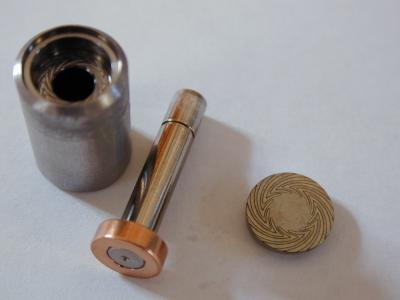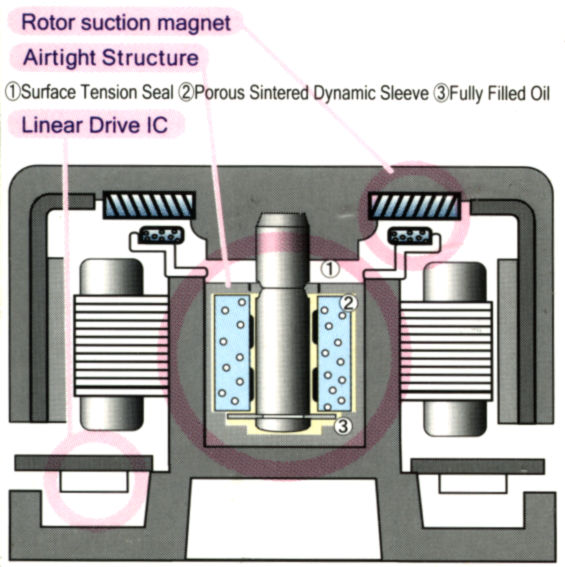Computer fan bearings
When I first got into messing with computer hardware, the received wisdom as regards fan bearings, for cooling fans on computers, was that there were two types, ball bearings and sleeve bearings, and that the tradeoffs were that ball bearings were noisier, but that sleeve bearings tended were less reliable, and tended to fail silently, likely letting the device they were cooling overheat and fail. Ball bearings get a lot noisier before they fail, and were thus the recommended solution for most purposes.
But these days, there are a variety of names for fan bearings. In Newegg’s list, today, of 120mm fans for sale, the various bearing types are described as follows (with each bearing type followed by the number of fan models that contain it):
- Sleeve (43)
- Ball (15)
- 2 Ball (19)
- 1 Ball, 1 Sleeve (2)
- Fluid Dynamic (17)
- Hydraulic (1)
- Hydro Wave (7)
- Nanoflux Bearing (NFB) (4)
- Ever Lubricate (11)
- EverLasting Quiet (1)
- Rifle (2)
- SSO (2)
- Z-AXIS (1)
Besides ball and sleeve, the principal alternative in that list is “fluid dynamic”. To computer people, fluid dynamic bearings have a high reputation, as being the thing that replaced ball bearings in hard drive spindles, making them a lot quieter. Hard drives no longer make an annoying whine just from spinning, like they did prior to about five to ten years ago (depending on manufacturer).
I disassembled a fluid dynamic bearing from a failed Seagate drive, to see how it worked. (The drive had failed with a head crash; the bearing was still fine.) Disassembling it required grinding, because it appeared to have been welded together (with a tiny, exquisite weld). Revealed was the following (click on the image to see a 4x larger version):

The main shaft of this bearing is an ordinary plain bearing (aka sleeve bearing): a cylindrical shaft rotating inside a cylindrical enclosure, separated by oil. Nothing special needs to be done to get the oil evenly-enough distributed to separate the two parts, since the shaft naturally drags the oil around with it. The trickery comes at the end of the shaft, where there is a bronze ring shrink-fit on to the shaft, to handle thrust (that is, loads coming from one end of the shaft or the other). This thrust bearing would, in the normal course of things, not have any sort of principle that would restore fluid to the interface; so the bronze ring would touch the steel enclosure. Although bronze and steel are a good combination for bearings, which gives relatively low friction and wear, still, spinning 24 hours a day, they’d wear out quickly if touching. To prevent this, the designers of this bearing have added a special pattern of grooves to the steel surfaces that would contact the bronze, as is visible in the photo; these re-direct fluid that would slip off an edge of the interface back into the middle of it. That way, the thrust surfaces touch each other only on startup of the hard drive spindle, a rare occasion and one during which it is not spinning particularly fast.
But the chances that anyone will ship such a beautiful piece of machinery inside an ordinary computer fan are pretty slim. Indeed, the computer fan bearings which I’ve taken apart, and which have been described as “fluid dynamic bearings”, operate on an entirely different principle. The shaft is the same sort of thing: a sleeve bearing. But the thrust is taken up differently. The following diagram, from a Scythe brand fan (which Scythe describes as having a fluid dynamic bearing made by Sony), is a good example:

Most of those parts are about the same as they would be on a sleeve bearing fan. The fan is held in by a plastic split washer that fits into a groove on the bottom of the fan spindle, as in an ordinary sleeve bearing fan. The porous bronze sleeve, filled with oil, is also usual in sleeve bearing fans. The difference is the “rotor suction magnet”, which takes the thrust load off the plastic split washer. The way computer fans are arranged, the force produced by the wind from the fan is trying to lift off the top of the bearing, on which the fan blades (not shown) are mounted. The magnet overcomes this force, replacing it with a force in the opposite direction, which gets taken on the bottom end of the shaft.
I can think of a couple of reasons why this might be better. One is that the bottom end of the shaft has a larger surface area than the groove which holds the plastic split ring, and so can handle the thrust force better. The flimsy plastic split ring also will bend a bit, likely making the surface area on which the thrust is taken even smaller. Another reason is that the magnet’s strength might be chosen so as to exactly counterbalance the wind force – although the wind force depends on a lot of things, including supply voltage and air pressures, and thus could never be exactly counterbalanced. In any case, the reason isn’t that the bottom end of the shaft sports any particular cleverness; when I took one of these bearings apart, there was nothing like the sort of oil flow channeling that the Seagate bearing had.
But whatever the reason, a lot of companies make such fans, using different names. Of the above fan bearing names, besides “Fluid Dynamic”, the “Nanoflux Bearing” and likely the “Ever Lubricate” bearings use this principle of having a magnet to take up the thrust force. In some designs, the magnet is put below the bottom of the shaft, to magnetically attract the steel end of the shaft. It is thus also sometimes called a “magnetic bearing”, a term which suggests the sort of ultra-expensive magnetic levitation bearing that Iraq was once trying to get hold of for their gas centrifuges for uranium. Such is marketing. As for what the generic name for such devices should be, I suggest “thrust magnet bearing”; it’s reasonably terse, and sort of conveys what the thing is. It won’t wildly excite marketing people, but I don’t think it’ll make them wince, either.
In other fans, ordinary sleeve bearings are described as “fluid dynamic bearings” – which in a sense they are, since sleeve bearings do involve fluid dynamics. The “Hydro Wave” bearing that I took apart was an ordinary sleeve bearing. This seems misleading, but not necessarily in any serious way: on the forum at silentpcreview.com, there seems to be a consensus that sleeve bearings are better than was traditionally thought. My guess is that this is because the denizens of that forum tend to operate their fans at low speeds, where there isn’t much thrust force. Also, even without any additional magnets, the magnetic field loop that is used to turn the fan provides a restoring force against thrust. In some sleeve bearing fans, the fan hub can be pulled out a few millimeters against that force before one hits the split washer that retains it. In those fans, especially in low-speed ones, adding thrust magnets is likely superfluous.
As for “rifle bearings”, the term is strange enough that I’ve ordered a couple of fans with them to see what they are; but one (marketed as an “air rifle bearing”) was just an ordinary sleeve bearing fan, and the other just a magnetically-counterbalanced bearing. The name suggests that either the shaft or its bearing would be rifled, but I don’t see what the point of doing either would be; it could pump all the oil out one end of the bearing, but that doesn’t seem sensible.
That pretty much exhausts Newegg’s list of names, although a couple of oddballs are left. Of course, as I hope was apparent, this article is not intended to be authoritative or up to date; that would be actual work and would cost actual money. It is just the result of having occasionally ripped apart a fan or two, over the years.